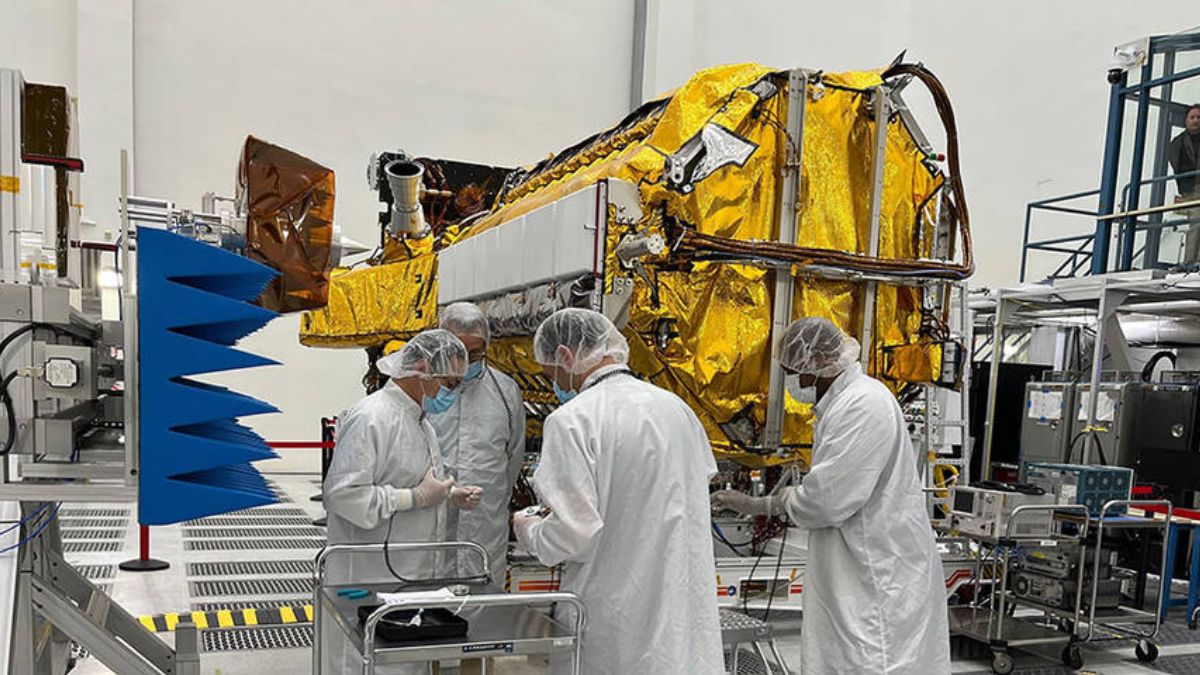Explainer: Why the second stage of the GSLV Mk II rocket is crucial to the NISAR Mission
 Engineers and technicians work on the science instrument payload for the NASA-ISRO Synthetic Aperture Radar (NISAR) mission in a JPL clean room | NASA/JPL-Caltech
Engineers and technicians work on the science instrument payload for the NASA-ISRO Synthetic Aperture Radar (NISAR) mission in a JPL clean room | NASA/JPL-Caltech
India is preparing for one of its most important space missions the launch of the NASA-ISRO Synthetic Aperture Radar (NISAR) satellite scheduled for June 2025.
The rocket that will carry this high-tech satellite is the Geosynchronous Satellite Launch Vehicle Mark II (GSLV Mk II), which has been developed by the Indian Space Research Organisation (ISRO).
The GSLV Mk II is a three-stage rocket with four liquid strap-on boosters. It stands 50.9 metres tall and is capable of carrying 2,500 kilograms to a Geosynchronous Transfer Orbit (GTO) or 5,000 kilograms to a Low Earth Orbit (LEO). Each stage of the rocket plays a key role, but the second stage (GS2) acts as a critical bridge between the powerful liftoff and the precision needed to place satellites into orbit.
The first stage of the GSLV uses a solid-fuel motor, assisted by four liquid-fueled boosters, to produce the initial thrust needed to escape Earth’s gravity. After this stage burns out, the GS2 takes over and continues to power the rocket upward.
The GS2, or second stage, uses a Vikas engine, which has been a reliable workhorse in many of ISRO’s past launches. It runs on liquid propellants—unsymmetrical dimethylhydrazine (UDMH) as fuel and nitrogen tetroxide (N₂O₄) as oxidiser. These are hypergolic propellants, meaning they ignite automatically upon contact with each other, which adds to their reliability and ease of ignition in space.
The GS2 burns for about 150 seconds, providing a steady and controllable thrust that helps the rocket maintain its correct path through the atmosphere. It is during this stage that the rocket must travel through the upper layers of Earth’s atmosphere, where aerodynamic forces are still active and corrections in the flight path may be needed. Unlike solid motors, which cannot be adjusted once fired, the liquid propulsion in GS2 allows for fine control, enabling the rocket to correct any early flight deviations.
Then comes the third stage (GS3), which is powered by cryogenic propellants—liquid hydrogen (LH2) and liquid oxygen (LOX). These are stored at extremely low temperatures and are more efficient than conventional fuels. The GS3 burns for around 720 seconds (12 minutes), giving the final push needed to insert the satellite into its precise orbit. This indigenously developed cryogenic stage is a significant achievement for India, marking self-reliance in advanced rocket technology.
But for the third stage to do its job properly, the second stage must first lift the rocket to the right altitude and velocity. If the GS2 underperforms, the cryogenic stage won’t have enough energy or time to adjust the satellite’s orbit. A similar issue happened in 2021 when the GSLV-F10 mission carrying the EOS-03 satellite failed due to a cryogenic stage malfunction. Though the issue lay in the upper stage, it reminded everyone how each stage of a rocket is interconnected—a failure in one part can jeopardize the whole mission.
On March 24, 2025, ISRO successfully flagged off the GS2 stage from its Propulsion Complex in Mahendragiri, Tamil Nadu, and transported it to the launch site at Sriharikota, marking a key milestone in the GSLV-F16 mission preparation. This readiness reflects ISRO’s engineering discipline, technical expertise, and high safety standards.
The upcoming launch will carry NISAR, a joint mission between NASA and ISRO. This satellite will monitor changes on Earth, such as deforestation, melting glaciers, natural disasters, and infrastructure development. It will orbit the Earth at a height of 747 km in a sun-synchronous polar orbit, using two radars L-band from NASA and an S-band from ISRO to scan the planet every 12 days, offering high-resolution data between 5 and 10 metres.
“Placing this advanced satellite in such a specific orbit requires flawless performance from each rocket stage, especially the GS2. The second stage determines whether the cryogenic engine can take over successfully. Any delay or deviation in this phase can compromise the final outcome,” remarked space expert Girish Linganna.
He also adds that the GS2’s contribution also highlights India’s growing mastery of liquid propulsion systems, which are not only more precise but also more complex to manage. “Building, assembling, fuelling, and testing a liquid stage involves great care to prevent leaks, pressure failures, or engine shutdowns. The successful handling of GS2 proves that ISRO is ready for the next level of space missions, including human spaceflight (Gaganyaan) and commercial launches through NewSpace India Limited (NSIL),” added Linganna.
Sci/Tech